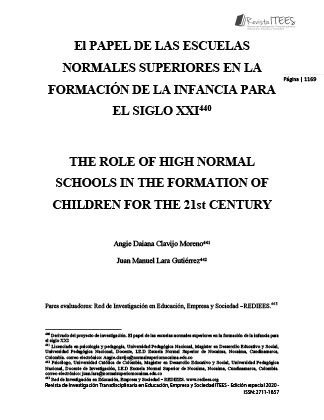LXI. THE ROLE OF HIGH NORMAL SCHOOLS IN THE FORMATION OF CHILDREN FOR THE 21st CENTURY
##plugins.themes.bootstrap3.article.main##
Abstract
In Colombia, the high normal schools constitute institutions that form educators for the
preschool and basic primary levels. Since their appearance in 1821 and given its work in
training the personnel in charge of early childhood education, these institutions have
undergone major transformations, not only responding to the changing educational policies
but also to the multiple conceptions, configurations, and practices around childhood. In this
order, the formation of this age group for the 21st century has been a topic that has mobilized
and disturbed the Colombian educational system; especially if the challenges posed by the
emerging modernization project in the 21st century are considered. Consequently, continued
questionings about how to train the new generations of the country and how this training
should be in accordance with the demands, changes and needs of the national context have
been present approaches both in the faculties of education of the universities and in the High
Normal Schools. Therefore, the present work aims to reflect on the role played by Higher
Normal Schools in the training of teachers for childhood; addressing critical items such as
rural education, unequal access to Information and Communication Technologies; and the
constant tensions that arise with government entities, given the increase in bureaucratic
procedures that hinder their continuity and operation.
Download Statistics
##plugins.themes.bootstrap3.article.details##
teacher training, childhood, higher normal schools, education
sociopolítico en la Reforma Instruccionista del Estado Soberano de Santander (1863-
1870), preámbulo de las Escuelas Normales en Colombia. Revista Historia de la
Educación Latinoamericana, 17 (25), 51-68.
Albero, M. (2002). Adolescentes e Internet. Mitos y realidades de la sociedad de la
información. Revista de estudios de comunicación, (13), 1-8.
Amador, J.C. (2012). Condición infantil contemporánea: hacia una epistemología de las
infancias. Pedagogía y Saberes, 37, 73-87.
Arias, J. (2017). Problemas y retos de la educación rural colombiana. Educación y Ciudad,
33, 53-62.
Báez, M. (2004). Las escuelas normales de varones del siglo XIX en Colombia. Revista
Historia de la Educación Latinoamericana, 6, 179-208.
Báez, M. (2002). El surgimiento de las escuelas normales femeninas en Colombia. Revista
Historia de la Educación Latinoamericana, 4, 157-180. Balen, C. (2016). Las
tecnologías de la información y las comunicaciones en el posconflicto colombiano.
Revista de ingeniería, 44, 40-45.
Botello, H. (2014). Determinantes del acceso a internet en Colombia. Ánfora, 37, 21-36.
Calvo, G., Rendón, D., y Rojas, L. (2004). Un diagnóstico de la formación docente en
Colombia. Revista Colombiana de Educación, (47), 1-15.
Hernández, R. (2014). Algunas consideraciones sobre la formación docente para el sector
rural. Actualidades Pedagógicas (63), 15-38.
Jiménez, A. (2008). Historia de la infancia en Colombia: crianza, juego y socialización, 1968-
1984. Anuario Colombiano de Historia Social y de la Cultura, 35, 155-188.
Liebel, M. (2016). ¿Niños sin niñez? Contra la conquista poscolonial de las infancias del Sur
Global. Revista Digital de Ciencias Sociales, 3 (5), 245-272.
Mara, S. (2009). Aportes para la elaboración de propuestas de políticas educativas. Urugay:
Dirección de Educación.
Ospina-Alvarado, M., Alvarado, S., y Fajardo, M. (2018). La niñez en contextos de conflicto
armado comprendida desde el construccionismo social, la socialización política y las
perspectivas alternativas del desarrollo humano: apuesta epistemológica desde el sur.
En Opsina-Alvarado, M., Alvarado, S., Carmona, J., Arroyo, A. (Eds.), Construcción
social de niñas y niños en contextos de conflicto armado. Bogotá, Colombia:
Fundación Centro Internacional de Educación y Desarrollo Humano; Universidad de
Manizales; COLCIENCIAS.
Rátiva, M. (2016). Las Escuelas Normales en Suramérica “El normalismo en vía de extinción”
Colombia ¿Cómo estamos? Revista Hojas y Hablas (13), 169-178





